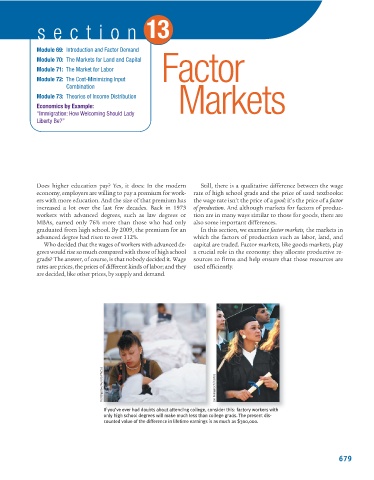Page 721 - Krugmans Economics for AP Text Book_Neat
P. 721
section 13
Module 69: Introduction and Factor Demand
Module 72: The Cost-Minimizing Input Factor
Module 70: The Markets for Land and Capital
Module 71: The Market for Labor
Combination
Module 73: Theories of Income Distribution Markets
Economics by Example:
“Immigration: How Welcoming Should Lady
Liberty Be?”
Does higher education pay? Yes, it does: In the modern Still, there is a qualitative difference between the wage
economy, employers are willing to pay a premium for work- rate of high school grads and the price of used textbooks:
ers with more education. And the size of that premium has the wage rate isn’t the price of a good; it’s the price of a factor
increased a lot over the last few decades. Back in 1973 of production. And although markets for factors of produc-
workers with advanced degrees, such as law degrees or tion are in many ways similar to those for goods, there are
MBAs, earned only 76% more than those who had only also some important differences.
graduated from high school. By 2009, the premium for an In this section, we examine factor markets, the markets in
advanced degree had risen to over 112%. which the factors of production such as labor, land, and
Who decided that the wages of workers with advanced de- capital are traded. Factor markets, like goods markets, play
grees would rise so much compared with those of high school a crucial role in the economy: they allocate productive re-
grads? The answer, of course, is that nobody decided it. Wage sources to firms and help ensure that those resources are
rates are prices, the prices of different kinds of labor; and they used efficiently.
are decided, like other prices, by supply and demand.
Tod Bigelow/Aurora Photos Jon Feingersch/Corbis
If you’ve ever had doubts about attending college, consider this: factory workers with
only high school degrees will make much less than college grads. The present dis-
counted value of the difference in lifetime earnings is as much as $300,000.
679

